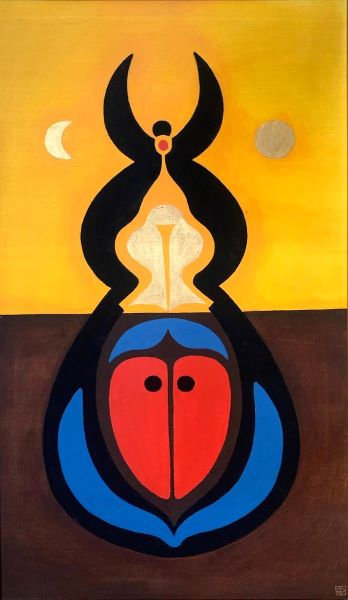Biography
The beginning of his painting was greatly influenced by the works of Erzsébet Vaszkó (e.g. A found object drawing series; Yellow composition), Endre Bálint, Jenő Barcsay (e.g. Winter landscape), Lajos Vajda (e.g. Self-portrait as a youth) and Dezső Korniss (e.g. Bug King).
Szemadám was employed at the Capital Zoo and Botanical Garden, where he became the big game keeper and then chief keeper between 1967 and 1975. Some of Szemadám's works made in these years also indicate his attachment to big cats, such as the Tiger Eye (1971) or Tiger Head I-II. oil paintings. In the first half of the 1970s, he was a participant and organizer of several happenings and performances. Among other things, in 1973 he performed a memorable identification experiment in the chapel hall in Balatonboglár. The photo documentation of the performance was made by László Haris, with whom they worked together several times. Haris took the documentary photos for almost all of Szemadám's actions and performances (e.g. Musical depressions freely - Battle for eight-hour music time, outdoor musical happening, 1972; Burning giraffe action, 1973; Street action - the "loss" of a wrapped, stuffed moose; Situation exercises, 1974).
The most memorable and infamous exhibition of the No 1 group was organized by Szemadám. It was May 8-11, 1971. "work exhibition" organized in the lion's cave of the Capital Zoo and Botanical Garden between they stand The group was supported by such great art historians as János Frank, who organized their first exhibition, and Ottó Mezei, who opened all three of their 1971 exhibitions.
Szemadám also created traditional panel pictures and oil paintings during these times. His paintings at that time are stylized, symbolic animals, often birds, abstract representations showing fragments of form, the stylistic characteristics of which are reduced forms, accentuated color fields and definite contours. Most of these works can be linked to classical avant-garde traditions. Where quite constructive image editing can be observed (Winter landscape), but they can mostly be integrated into the range of organic abstraction (Red-blue composition, Bird, Tiger's head, Bug king). He also has surreal-figurative compositions (The house of the red cat, Mermaids), and the cult world of icons and masks is also recalled in several of his works made at that time (Saint, Youth self-portrait, The severed head of St. John the Baptist). These threads continue to live on in his later art, ensuring thematic and stylistic continuity in his oeuvre.
From 1979, he led art circles and creative camps with the participation of children and adults, held other art classes, performed art therapy work in mental hospitals, and led the creative employment of disadvantaged children and youth in family support centers. Between 1982-1993, he was a teacher of the GYIK (Children's and Youth Fine Arts) Workshop at the Hungarian National Gallery, and from 1988 its leader. In 1992-1993, he worked as a senior employee of the Hungarian Cultural Institute, and in 1998-2001 as a board member. Between 1997 and 1999, he was the editor-in-chief of the Visual Arts Editorial Department of Hungarian Television.
From the second half of the 1980s, György Szemdám's entire expression becomes classicized and figurative, and his painting method is characterized by meticulousness, elaborateness, and strong contours, while partially remaining with his earlier themes. In addition to the use of traditional tools, other different arenas of archaization can be observed. One is the personal relationship with the already mentioned (historical) past as a perspective. These include his works on which art historical topos or quotations, and sometimes paraphrases of well-known works of art, appear, so that the historical and art historical pre-images emerge in a new relation. In contemporary art, the use of this kind of foreshadowing and quotations is also closely related to archaism.

